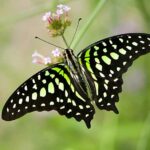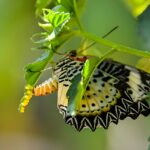Step into the enchanting world of butterflies, where whispers of purple add a touch of magic to their wings. In the vast spectrum of nature’s colors, purple butterflies hold a special allure, blending fantasy with reality.
This article uncovers 16 species that flirt with shades of purple, revealing their unique charm and the environments they adorn.
Is the Purple Butterfly Real?
True purple butterflies, with naturally purple pigmented wings, are a rarity in nature. However, some butterfly species exhibit a purple appearance due to iridescence – a natural phenomenon where light reflects off their wings, creating a shimmering effect that can make them appear purple.
| Size | Color | |
|---|---|---|
| Florida Purplewing | 1-2 inches | Blue wings with purple margins |
| Pavon Emperor | 2-3 inches | Brown wings with blue to purple |
| Purple Crow Butterfly | 4 to 8 cm | Black wings with purple hue |
| Purple Owl-Butterfly | Up to 120mm | Blue, black, and purple wings |
| Lesser Purple Emperor | 2.5-3.5 inches | Purple wings with orange eyespots |
| Striped Blue Crow Butterfly | 3-4 inches | Blue to purple forewings |
| Agathina Emperor | 2-3 inches | Blue to purple wings |
| Dingy Purplewing | 1-2 inches | Dark brown wings with purple hue |
| Purple Emperor | 2.8–3.1 inches | Black and purple wings |
| Freyer’s Purple Emperor | 7.5-8.4cm | Mostly purple wings |
| Great Purple Emperor | Up to 2.6 inches | Broadly purple wing coloration |
| Purple Cerulean | 2-3 inches | Dark purple wings |
| Purple Beak | Varies | Purple and pink wings |
| Pansy Daggerwing | 5 – 6 centimetres | Purple hindwings |
| Purple-washed Eyed-Metalmark | Varies | Black and blue or purple colors |
| Powdered Oakblue | 2-3 inches | Large purple sections on wings |
1. Florida Purplewing

The Florida Purplewing (Eunica tatila), with its striking blue wings edged in dark brown to purple, is a small wonder with a wingspan of just 1 to 2 inches.
Native to the Southeastern US, Texas, and Kansas, and extending its range to Mexico and South America, this species thrives in woodlands and near water sources.
The white dots on its forewings add to its distinctive appearance, and it’s often seen feeding on decaying fruit, a diet that sets it apart from many other butterfly species.
2. Pavon Emperor

The Pavon Emperor (Doxocopa pavon) is a visually striking butterfly, primarily found in Southern Texas, Mexico, and South America.
Males of this species exhibit brown wings with an overlay of blue to purple, making them stand out in their tropical habitats. The wings feature large orange spots on the upper side of the forewings, adding to their beauty.
These butterflies are not just a feast for the eyes but also play a crucial role in their ecosystems, feeding on flower nectar and sometimes extracting moisture and nutrients from mud.
3. Purple Crow Butterfly

Native to Taiwan, Vietnam, and other Asian countries, as well as Australia, the Purple Crow Butterfly (Euploea tulliolus) is known for the purple hue of its black wings. This subtle purple tint becomes more visible under direct sunlight, especially around noon.
The Purple Crow Butterfly is renowned for its managed migrations, moving with the seasons in search of food.
In some urban areas, these migrations are so significant that local authorities manage them, highlighting the butterfly’s importance in the region’s biodiversity.
4. Purple Owl-Butterfly

Among the largest in the world, the Purple Owl-Butterfly (Caligo beltrao) is a remarkable species with a wingspan stretching to 120mm.
It exhibits a unique combination of blue, black, and purple on its wings, with the inner parts near the body being blue and the outer parts black with purple hints.
The small orange tips on the upper forewings and white sections on the lower hindwings close to the body add to its majestic appearance. This species’ coloration is influenced by its diet, primarily feeding on purple arrowroot.
5. Lesser Purple Emperor

Found next to poplar woodlands, the Lesser Purple Emperor (Apatura ilia) is one of the few butterflies with a truly purple appearance.
This species displays various morphs, but almost all feature some degree of purple coloring across the wings.
Males typically have purple areas across both the forewings and hindwings, complemented by white and gray areas and orange eyespots on the forewings.
The ventral coloring of the Lesser Purple Emperor is tan, gray, and light orange, with a duller appearance compared to the vibrant dorsal side.
6. Striped Blue Crow Butterfly

The Striped Blue Crow Butterfly (Euploea mulciber), with its blue to purple forewings adorned with white spots and black margins, is a sight to behold. Its dark hindwings, partly gray and partly brown, add to its unique appearance.
This butterfly’s ventral coloring also features blue with purple nuances and light white or blue spots on the forewings.
Native to Southeast Asia, the Striped Blue Crow Butterfly is a rare and enchanting species, contributing significantly to the region’s ecological diversity.
7. Agathina Emperor

The Agathina Emperor is a small but striking butterfly (Doxocopa agathina), mostly found in Brazil’s Amazon. Males of this species have blue to purple wings, covering almost the entire surface of both the forewings and hindwings.
The orange spots across the outer forewings and an orange margin on the upper forewings enhance their beauty. Females, on the other hand, are brown with a wide orange band running diagonally away from the body.
The ventral coloring in both males and females is based on brown and gray nuances, showcasing the species’ adaptability to its environment.
8. Dingy Purplewing

The Dingy Purplewing (Eunica monima), native to subtropical forests in Florida and Texas and also found in Central America, is known for its dark brown coloring with a purple nuance on the dorsal wings. Its ventral wings are mostly blue to purple as well.
Unlike many other colorful butterflies, the Dingy Purplewing has a unique diet, feeding on dung. This unusual food choice is a fascinating aspect of its ecology, differing from the typical nectar-feeding habit of most butterflies.
9. Purple Emperor

The Purple Emperor (Apatura iris) is a species with a purple morph, making it one of the more unique butterflies in its genus. Interestingly, this morph shows one purple wing with black coloring, while the other wing is mostly black.
These color differences are not seen in other brown morphs of the Purple Emperor. Found in oak woodlands, where oak trees serve as hosts for its caterpillars, these butterflies feed on the honeydew of oak-feeding aphids and are also known to feed on carrion.
10. Freyer’s Purple Emperor

Native to Europe and Asia, Freyer’s Purple Emperor (Apatura metis) is found in wet woodlands where it feeds on carrion and mud. This butterfly species is mostly purple, with orange marks decorating its wings and a mostly gray to brown body.
The light brown wings with white markings mirror the shape and size of their dorsal white marks. The shrinking natural habitat due to deforestation has been linked to a decline in the number of Freyer’s Purple Emperors, highlighting the importance of conservation efforts for this species.
11. Great Purple Emperor

The Great Purple Emperor (Sasakia charonda), the national butterfly of Japan, features broadly purple wing coloration with blue undertones, wide black margins, and large white spots.
Unlike other purple butterflies that grow to a wingspan of up to 2 inches, Great Purple Emperors can reach up to 2.6 inches.
Hackberries are among the most common host trees for this species, playing a crucial role in its life cycle.
12. Purple Cerulean

The Purple Cerulean (Jamides phaseli), native to Australia, particularly in the northern regions, is a species with dark purple wings, black and white margins, and black veins.
The black body with white bands across the lower body is specific to this species, along with large black sections on the lower part of its hindwings.
The Purple Cerulean’s unique coloration and patterns make it a notable species in Australia’s butterfly fauna.
13. Purple Beak

The male Purple Beak (Libythea geoffroy) is predominantly purple, with purple forewings and pink to purple hindwings. Females, however, display a different coloration with no purple nuances at all, featuring brown and black as the main colors.
The ventral wings are similarly colored to the dorsal wings, and these butterflies and their caterpillars can be seen on hackberry trees, which serve as their primary food source.
14. Pansy Daggerwing

The Pansy Daggerwing (Marpesia marcella), a butterfly of multiple subspecies found in Central and South America, particularly in Panama, is known for its large wings and three main colors, including purple.
The hindwings are black on the margins with purple coloring, while the forewings feature orange and black colors with black bands. The Pansy Daggerwings also feature black tails, adding to their distinct appearance.
15. Purple-washed Eyed-Metalmark

Native to tropical and neotropical climates, the Purple-washed Eyed-Metalmark (Mesosemia lamachus) is found in Costa Rica, Panama, and El Salvador.
This species comes in black and blue or black and purple colors and stands out with its patterns and eyespots.
The forewings are mostly dark brown or black with large black eyespots with yellow borders, while the hindwings are mostly purple or blue with black stripes and wider black margins.
16. Powdered Oakblue

The Powdered Oakblue (Arhopala bazalus), with its ventral dull appearance and colorful dorsal appearance, is a species that doesn’t attract attention when its wings are closed, sometimes even resembling a dead leaf.
The dorsal wing coloring shows their colorful appearance due to the large purple sections of the forewings, combined with black margins.
Native to Southeast Asia, the Powdered Oakblue is commonly spotted with a wingspan of around 2-3 inches.
Conclusion
Our journey through the world of these almost-purple butterflies unveils a spectrum where fantasy brushes against reality.
Each of the 16 species, from the delicate hues of the Purple Crow to the vibrant patterns of the Striped Blue Crow, paints a picture of nature’s playful palette.
While true purple remains a dream, the glimpses we catch in these butterflies remind us of nature’s capacity for wonder, inviting us to look closer and admire the diverse tapestry of life around us.
FAQs
True purple butterflies, with entirely purple pigmented wings, are extremely rare. However, many species appear purple due to iridescence or specific patterns.
The purple appearance in some butterflies is often due to the way light reflects off their wings, creating an iridescent effect that can make them look purple.
Some species, like the Purple Crow Butterfly, are known to migrate through urban areas, making them visible in cities during certain times of the year.
While there’s no specific ecological significance unique to purple butterflies, their rare and captivating coloration makes them a subject of interest and admiration.



